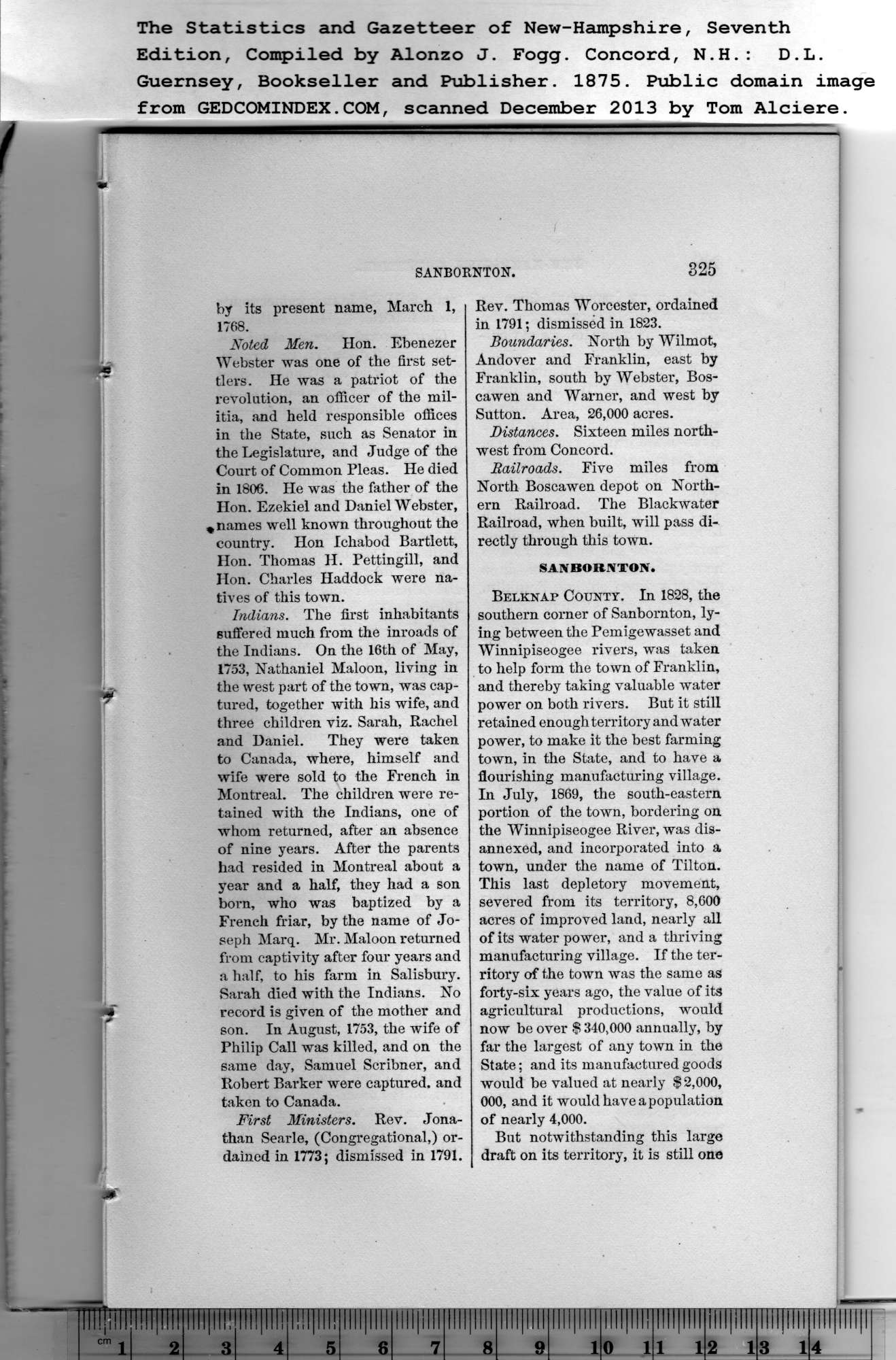|
by its present name, March I,
IT68.
Noted Men. Hon. Ebenezer
Webster was one of the first set-
tlers. He was a patriot of the
revolution, an officer of the mil-
itia, and held responsible offices
in the State, such as Senator in
the Legislature, and Judge of the
Court of Common Pleas. He died
in 1806. He was the father of the
Hon. Ezekiel and Daniel Webster,
* names well known throughout the
country. Hon Icliabod Bartlett,
Hon. Thomas H. Pettingill, and
Hon. Charles Haddock were na-
tives of this town.
Indians. The first inhabitants
suffered much from the inroads of
the Indians. On the 16th of May,
1753, Nathaniel Maloon, living in
the west part of the town, was cap-
tured, together with his wife, and
three children viz. Sarah, Rachel
and Daniel. They were taken
to Canada, where, himself and
wife were sold to the French in
Montreal. The children were re-
tained with the Indians, one of
whom returned, after an absence
of nine years. After the parents
had resided in Montreal about a
year and a half, they had a son
born, who was baptized by a
French friar, by the name of Jo-
seph Marq. Mr. Maloon returned
from captivity after four years and
a half, to his farm in Salisbury.
Sarah died with the Indians. No
record is given of the mother and
son. In August, 1753, the wife of
Philip Call was killed, and on the
same day, Samuel Scribner, and
Robert Barker were captured, and
taken to Canada.
First Ministers. Rev. Jona-
than Searle, (Congregational,) or-
dained in 1773; dismissed in 1791. |
Rev. Thomas Worcester, ordained
in 1791; dismissed in 1823.
Boundaries. North by Wilmot,
Andover and Franklin, east by
Franklin, south by Webster, Bos-
cawen and Warner, and west by
Sutton. Area, 26,000 acres.
Distances. Sixteen miles north-
west from Concord.
Railroads. Five miles from
North Boscawen depot on North-
ern Railroad. The Blackwater
Railroad, when built, will pass di-
rectly through this town.
SANBORNTON.
Belknap County. In 1828, the
southern corner of Sanbomton, ly-
ing between the Pemigewasset and
Winnipiseogee rivers, was taken
to help form the town of Franklin,
and thereby taking valuable water
power on both rivers. But it still
retained enough territory and water
power, to make it the best farming
town, in the State, and to have a
flourishing manufacturing village.
In July, 1869, the south-eastern
portion of the town, bordering on
the Winnipiseogee River, was dis-
annexed, and incorporated into a
town, under the name of Tilton.
This last depletory movement,
severed from its territory, 8,600
acres of improved land, nearly all
of its water power, and a thriving
manufacturing village. If the ter-
ritory of the town was the same as
forty-six years ago, the value of its
agricultural productions, would
now be over $ 340,000 annually, by
far the largest of any town in the
State; and its manufactured goods
would be valued at nearly $ 2,000,
000, and it would have a population
of nearly 4,000.
But notwithstanding this large
draft on its territory, it is still one |
